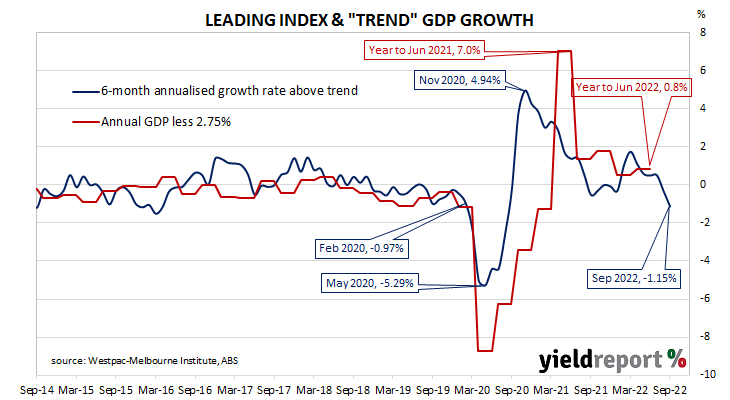Summary:Leading index growth rate down again in September; weakest since pandemic first hit; reading implies annual GDP growth of around 1.60%; ACGB yields finish higher; rate-rise expectations firm; consistent with economic slowdown in 2023.
Westpac and the Melbourne Institute describe their Leading Index as a composite measure which attempts to estimate the likely pace of Australian economic growth in the short-term. After reaching a peak in early 2018, the index trended lower through 2018 and 2019 before plunging to recessionary levels in the second quarter of 2020. Subsequent readings spiked towards the end of 2020 but then trended lower through 2021 and 2022.
The September reading of the six month annualised growth rate of the indicator registered -1.15%, down from August’s figure of -0.33% after it was revised from -0.38%.
“The Leading Index continues to point to a material loss in momentum to a below-trend growth pace heading into 2023,” said Westpac Chief Economist Bill Evans. “The September Leading Index read is the weakest since the pandemic first hit in 2020 and, prior to that, since early 2016.”
Index figures represent rates relative to “trend” GDP growth, which is generally thought to be around 2.75% per annum in Australia. The index is said to lead GDP by “three to nine months into the future” but the highest correlation between the index and actual GDP figures occurs with a three-month lead. The current reading thus represents an annual GDP growth rate of around 1.60% at the end of the December quarter.
Domestic Treasury bond yields moved higher on the day. By the close of business, the 3-year ACGB yield had gained 5bps to 3.58% while 10-year and 20-year yields both finished 3bps higher at 3.97% and 4.28% respectively.
In the cash futures market, expectations of higher rates firmed. At the end of the day, contracts implied the cash rate would rise from the current rate of 2.56% to 2.82% in November and then increase to 3.025% in December. May 2023 contracts implied a 3.84% cash rate while August 2023 contracts implied 4.02%.
Evans said this latest result is consistent with Westpac’s forecast of an economic slowdown in 2023. Westpac expects 3.4% GDP growth for calendar 2022 but only 1.0% GDP growth in 2023, driven by “sharp slowdown in consumer spending” as interest rates rise and the labour market softens.


